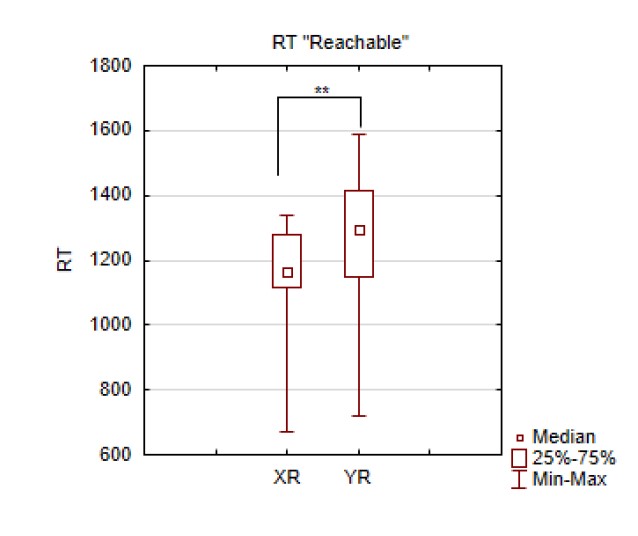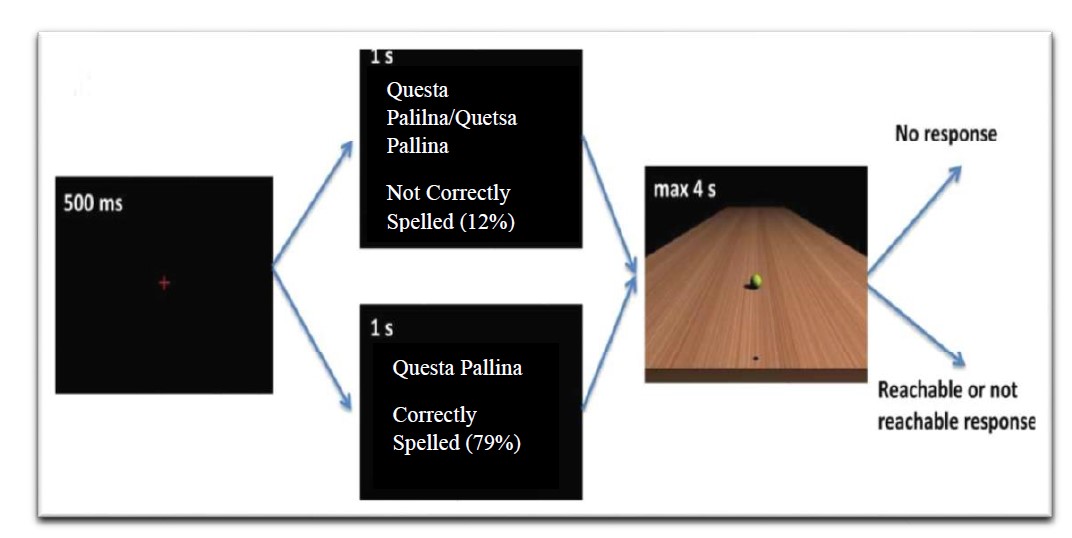Category: Parkinson's Disease: Cognitive functions
Objective: Action language is recognized as impaired in Parkinson’s disease (PD), proposing a functional role for the motor system in understanding action words [1]. This study aims to evaluate in PD patients the presence of a compatibility effect for the matching “this” and “that” respectively with a reachable and an unreachable object.
Background: The demonstratives “this” and “that” are linguistic terms that embody information regarding both the position of objects (respectively near and far space) and the possibility to interact with them, thus eliciting motor system activation.
Method: PD patients performed a reachability judgement task [2] of an object presented at different distances (near, intermediary, far) after having evaluated the correct spelling of both an Italian demonstrative (questo-this or quello-that) and an object noun (Figure 1). The sample was divided both according to the severity of the motor symptoms (less and more severity, respectively Group 1 and 2) and to the duration of the disease (below and above 8 years, respectively Group A and B).
Results: Overall, the results show that spatial demonstratives do not influence rechability judgments according to the group, because they may not be correctly processed by PD patients from the earliest stage of the disease. It is found a facilitation effect of the space regardless of the demonstrative presented before, with reaction times (RTs) being faster for objects in the near-reachable space compared to other distances within every group. The general facilitation effect of reachable space should be related to a dissociation in PD patients between an impaired automatic self-directed movements and relatively preserved goal-directed movements, such as reaching, reflecting a functional differentiation within the basal ganglia. Finally, a partial compatibility effect is found within the Group 2 with faster RTs for the reachable space judgement when the demonstrative “this” is presented before (Figure 2). This partial compatibility effect in Group 2 could be related to an involvement of preserved cortical network exploited to overcome the deficits within the motor striatal frontal loop.
Conclusion: This study confirms the importance of the cognitive-motor coupling in PD, showing a language processing impairment from the earliest stages of the disease and pointing out compensatory cognitive and motor skills.
SinDem4juniors, Bressanone,Italy,27-29 April,2022
References: 1. Boulenger, V., Metchouff, L., Thobois, S., Broussolle, E., Jeannerod, M. & Nazir, T.A. (2008). Word processing in Parkinson’s disease is impaired for action verbs but not for concrete nouns. Neuropsychologia, 46, 743–756. doi:10.1016/j.neuropsychologia.2007.10.007.
2. Coello, Y. & Bonnotte, I. (2013). The mutual roles of action representations and spatial deictics in French language. Quarterly Journal of Experimental Psychology, 66 (11), 2187–2203. doi:10.1080/17470218.2013.775596.
To cite this abstract in AMA style:
C. Giacobbe, Y. Coello, G. Santangelo. Embodied language in Parkinson disease: the case of demonstrative [abstract]. Mov Disord. 2022; 37 (suppl 2). https://www.mdsabstracts.org/abstract/embodied-language-in-parkinson-disease-the-case-of-demonstrative/. Accessed November 8, 2025.« Back to 2022 International Congress
MDS Abstracts - https://www.mdsabstracts.org/abstract/embodied-language-in-parkinson-disease-the-case-of-demonstrative/


